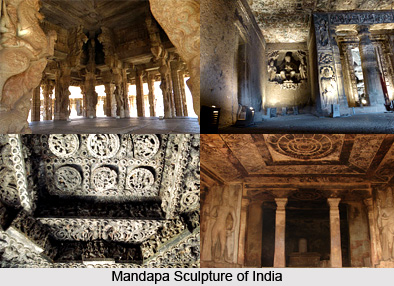 The gopuram leads to the `mandapa,` an important unit of the Western Chalukyan temple sculpture. There are two types Western Chalukyan manatapa: the dome shaped ceilings and the square ceilings. The dome ceiling is generally built on four pillars. This pillared structure is constructed on rings of stones. Within the mandapa lies the sanctum-sanctorum or the `garbhagriha` that is used as the prayer hall. The pillars on which the dome is built is not a cemented one. The rings of stone are kept one after the other and they are held in place by the immense weight of the roof top.
The gopuram leads to the `mandapa,` an important unit of the Western Chalukyan temple sculpture. There are two types Western Chalukyan manatapa: the dome shaped ceilings and the square ceilings. The dome ceiling is generally built on four pillars. This pillared structure is constructed on rings of stones. Within the mandapa lies the sanctum-sanctorum or the `garbhagriha` that is used as the prayer hall. The pillars on which the dome is built is not a cemented one. The rings of stone are kept one after the other and they are held in place by the immense weight of the roof top.
The triangular empty spaces that appear while building the dome shaped mandapa have been filled with arabesques. In case of the square shaped manadapas these nooks display etched out lotuses, rosettes and figures that have been drawn from Hindu mythology. As far as the mandapa architecture is concerned the pillars form an integral part for these structures. The pillars two are of two kinds. Pillars are seen in the Western Chalukya temples with alternate square blocks and sculptured cylindrical ones with plain square block bases. Pillars in bell shape are also a predominant feature of the manadapa sculpture. Some of the temple pillars were left unpolished. However some of the pillars of Itagi, Hangal and Bankapura flaunt polished finish.



















